MOSCOW – In the late eighteenth century, Catherine the Great planned a tour of Crimea, which her court favorite, Count Grigory Potemkin, had conquered a few years earlier. But while Potemkin had managed to seize the agriculturally rich peninsula from the Ottoman Empire, he had failed to achieve the promised colonization.
To save face, Potemkin ordered the construction of a row of painted pasteboard façades beside the river along which the empress would travel, and brought in cheerful villagers and herds of healthy livestock to complete the illusion. There was no prosperity, but it sure looked like there was.
Versions of “Potemkin villages” have been a staple of Russian history ever since. During Soviet times, the image that communism improved life for all obscured systemic violence and repression. And today, the Kremlin works tirelessly to create the impression that Russia is a beacon of stability and strength, and that a grateful people is fervently devoted to their leader, Vladimir Putin; but behind the façade, one finds disillusion, despair, fear, and rage.
You see this truth in contemporary Russian films and television, because popular culture finds it hard to lie completely about the state of politics. In the Russian crime drama The Boy’s World: Blood on the Asphalt, violent and chaotic politics translate into violent and chaotic streets. When leaders insist that enemies lurk everywhere and that the best defense is to strike first, paranoia, intolerance, and aggression grow.
It should be no surprise, then, that as Putin wages war on Ukraine, Russian children bully their classmates; teenagers film themselves attacking local residents; and adults get into public brawls.
Today’s Russia is nothing like the citadel of stability and satisfaction nor the bastion of prosperity that the Kremlin claims it to be. Though Russian GDP grew by more than 3% in 2023, despite Western sanctions, this hardly reflects genuine, let alone sustainable, economic dynamism.
Instead, it reflects the fact that the state has poured massive resources into the military-industrial complex. But those resources had to be reallocated from somewhere, and a series of catastrophes – including infrastructure disasters, energy-supply breakdowns, and fires at factories and warehouses – offer clues about where.
Moreover, the Ukraine war triggered a mass exodus of Russians, including many with valuable skills, such that 85% of businesses are now reporting a shortage of qualified manpower. Some estimate that, by 2030, Russia will be short up to four million capable workers, which would shave about two percentage points from GDP growth.
As in any dictatorship, the more problems Putin’s regime has, the louder the propaganda. This explains why last November – on National Unity Day – a massive “forum and exhibition” simply called “Russia” opened in Moscow. The six-month event, timed to end after the presidential election in March, is intended to be a “large-scale projection of the country,” with 131 expositions showcasing Russia’s “main achievements,” from “breakthrough discoveries” to Russian “victories” in “industry, culture, and sports.”
The Russia that the exhibition presents might be as glorious as Putin claims, but like Potemkin’s villages, it is a blatant attempt to obscure a dark truth with appealing lies. Moreover, it is being used to bolster Putin’s cult of personality. In this sense, the choice of venue for the event could not be more appropriate: the Exhibition of Achievements of the National Economy (VDNKh) was built at the height of Stalin’s purges.
Putin’s image and avatar preside over the proceedings, talking to workers, meeting with doctors, and praying with clergy on giant screens positioned in the venue’s pavilions. Meanwhile, the exhibition’s gift shop sells merchandise plastered with quotes from the president. “The Russian flag can’t bother anyone,” declares a t-shirt. “It’s equally honorable to be our friends and our enemies,” adds a sweatshirt.
For Russians who can’t make it to the VDNKh gift shop, similar quotes were featured on giant outdoor screens across the country during the first two weeks of this year. “The golden reserve of the nation is its people,” Russians were reminded as they walked down the street. “We can do anything when our road is lit with love for the fatherland.”
This is the language learned in Soviet Dictator 101. No one can forget the posters of Stalin in a cream-colored military-style jacket handing out ice cream to happy children, looming over tilled fields and crowds of peasants, or simply looking proudly into the distance. Images of him were ubiquitous during his rule, plastered onto the sides of buildings, carried as banners in parades, even woven into carpets. Others, from Lenin to Brezhnev, also produced posters touting their simultaneously grand and bland pronouncements.
The goal of current Kremlin propaganda is not to convince people that life in Russia is safe and prosperous. It might have started out that way, but as the Ukraine war drags on, Putin has had to adapt. Now, echoing Stalin’s narrative that progress toward socialism brings more challenges, requiring intensification of the class struggle, Putin is using propaganda to prepare Russians for more war.
The effort is hardly covert. On January 14, a Ministry of Defense pavilion titled “Army for children. City of professions. Future of the country” was opened at the VDNKh exhibition. On the same day, another Moscow exhibition – “The Trial. Franz Kafka and 20th-Century Art,” held at the Jewish Museum (also known as the Tolerance Center) – was closed.
What Russia needs today are precisely the messages the Kafka exhibition delivered: the Soviet system was absurd, but capable of ruthless efficiency in crushing innocent individuals. Instead, the messages Russians are now receiving are becoming more militarized and less tolerant by the day – a façade behind which lie sham elections, a weakening economy, and proliferating violence. Potemkin would be proud.
Copyright: Project Syndicate, 2024.






